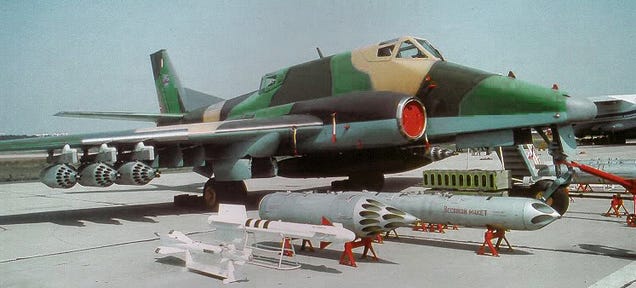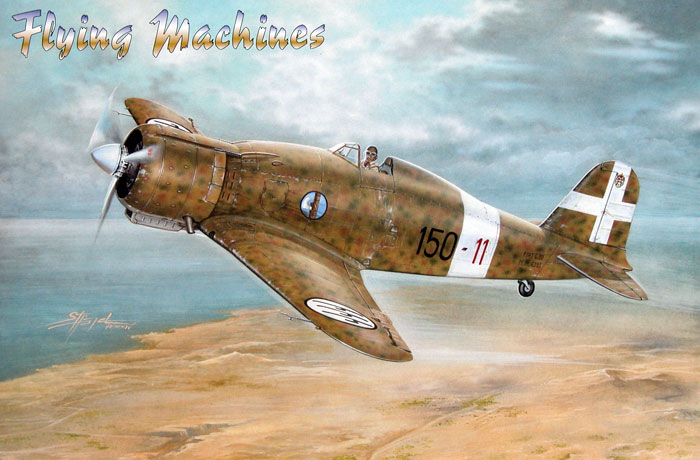
Posted on 07/11/2014 11:00:07 PM PDT by sukhoi-30mki

When we talk about combat aircraft that are so ugly they are brutishly beautiful, aircraft like the A-10, B-52 and the Mi-24 come to mind. Yet an obscure Russian close air support aircraft that lost a competition to the now notorious Sukhoi Su-25 may take the trophy for the must gorgeously ugly combat jet of all time.
By the late 1960s Russia was looking for a new jet aircraft that would be dedicated to close air support (CAS). After studying close air support scenarios and data collected since WWII it was clear that the fast, swept-wing jets and heavy bombers in inventory at the time could not get down low and slow enough to identify targets and attack them on multiple passes.
Even worse, they were all lightly armored and one well placed bullet or piece of shrapnel could turn them into a fiery wreck diving towards enemy held territory. From this study, requirements were put forward for an aircraft that had to be able to carry plentiful stores, had to be able to fly low to identify enemy targets, and it had to be able to take serious battle damage in the process.
A similar program known as the Attack Experimental (AX) was running at the Pentagon during this same time period, which would result in the YA-10 and YA-9 prototype aircraft. Strangely enough, the Northrop YA-9 would have large similarities to the Soviet designed SU-25. In the end, the Fairchild YA-10 won the US competition and the rest is 30mm spewing history.
Back to the Soviet competition, Ilyushin attacked the CAS/battlefield interdiction mission with a heavy hand and relied primarily on lessons learned from their famous Il-2 piston-powered attack aircraft of WWII vintage. In many ways Ilyushin had close air support and tactical ground attack in their ancestry more than any other Soviet aircraft design bureau. In fact, the whole dedicated close air support jet aircraft concept was already attempted by Ilyushin during the 1950s in the form of the extremely strange looking Il-40.
The Il-40 looked like a flying double-barreled shotgun, with its dual air intakes protruding far out on the front of the aircraft's fuselage. This strange design was due to issues with gas ingestion and subsequent jet engine flame-outs caused by the jet's planned six 23mm cannons. The design also featured some fairly heavy armored plating and like its famous Il-2 predecessor, a rear mounted machine gun on the jet's tail, with the gunner sitting at about the aircraft's trailing-edge wing root in a small cockpit enclosure. In the end, the Il-40 was cancelled due to changing organization within the Soviet Air Forces and the push for high-speed, swept wing jets for both attack and air-to-air combat duties.
Ilyushin stuck with the Il-2 and Il-40 general configuration with its new Il-102, but put more powerful engine technology to use and added much more armor and payload carrying capability. The Il-102 was truly a flying tank that housed a crew of two, a pilot upfront and a gunner in the rear. The gunner controlled the tail "stinger" twin-barreled 23mm gun assembly remotely.
The idea behind keeping the tailgun was that enemy fighters may have a hard time locking onto the low flying Il-102 due to ground clutter, so they would have to descend down to its level and would attempt a tail-shot on the unaware Il-102. Thus the gunner would keep the enemy fighters at bay by spraying 23mm cannon fire at them.
The whole tail-gunner idea was really a hold-over from WWII and would have had little use on the battlefield of the 1980s and beyond as all-aspect heat seeking missiles and pulse doppler radar sets would make any advantage gained by such an elaborate defensive setup very small. Still, the second crewman could do other things, especially when it comes to spotting targets and working the radios with friendly ground units.
The Il-102 could pack a serious offensive punch, with over 15,000lbs of munitions being able to be carried into battle. The jet had eight hardpoints for mounting rocket pods and missiles under its thick wings, and it also had six small bomb bays built into the wings themselves. These bays held individual munitions internally so that any performance drain they would cause on the aircraft would be a result of their weight alone, not drag. A 30mm cannon was also mounted externally on the centerline of the jet's belly. The GSh-30-2 cannon was capable of slinging depleted uranium penetrating rounds a about 2,400 rounds per minute.
When it came to armor, some say that Ilyushin went overboard with heavily armoring everything on the jet including its cockpit, engines, and subsystems using fairly rudimentary and dense plating. The fuel tanks were mounted in the dorsal section of the aircraft which protected them against ground fire as well. Although Sukhoi also took a armored approach with its Su-25, there was more of a willingness to trade kinematic performance for heavy armor plating in certain areas of their design, which helped in streamlining the whole package. The Il-102 was about 10,000 lbs heavier than the Su-25 and it used larger motors than its competitor, opting for a non-afterburning version of the MiG-29's thirsty RD-33 engines to move it along.
By the mid 1970s, proposals from Sukhoi, Mikoyan and Ilyushin were put forward, and Sukhoi's design was chosen as the winner. Some say this was due to the Su-25 winning on multiple perimeters, although they would have been highly theoretical as only the Su-25 prototype was near flying at the time and Mikoyan and Ilyushin's prototypes did not exist at all.
The fact that Sukhoi's actually had a prototype in the works may have been what caused the Su-25 to be chosen over its paper competitors, as the US had already chosen their new CAS aircraft, the A-10A Thunderbolt II. While others state the Il-102's heavier design and antiquated tailgun setup is what killed the tank buster to be. The IL-102 was said to have been cheaper to build, easier to maintain, and incredibly strong when it comes to the jet's structure, often with redundant load-bear structures throughout the aircraft's wings and fuselage.
Regardless of the fact that the Su-25 won the Soviet CAS aircraft requirement, Ilyushian continued with its IL-102 concept and the prototype was slowly assembled during the later half of the 1970s and early 1980s. Ilyushin was so convinced that their aircraft was superior for the the CAS mission, especially on cost, ruggedness and maintainability, that they continued with the project on internal funding and without a Soviet production contract. Supposedly Ilyushin thought there may be an export market for such a hard hitting, simple and robust CAS aircraft, even though the more nimble Su-25 was readily available.
The Il-102 finally flew in 1982, and continued flying some 367 test sorties, all of which were said to have been wildly successful, with Ilyushin test pilots giving the jet the highest marks possible. Then in 1984, the only flying prototype had an engine fire that would heavily damage the aircraft. The ground test prototype was said to have been too costly to have been converted to a flying example and the whole program was sadly abandoned.
Strangely enough, the Il-102 popped up again, albeit on the ground only this time, and with some theoretical upgrades, at the 1992 Moscow Air Show, and Sukhoi was actively pushing it as an export alternative to the Su-25. The jet was said to be capable of turning full circle in as little as 400 m, and had the same thrust to weight ratio and wing-loading as the smaller Su-25, all with cheaper acquisition and sustainment costs. The tailgun could be operated by the pilot in a semi automatic mode using a radar and the rear gunners station could be removed on production examples which would have saved well over 1,800 lbs.
Although the Il-102 had no shortage on character, it did have a shortage of firm orders and although there was interest in the aircraft in the early 1990s by foreign powers, the sorry state of Russia's aerospace industry ended up deterring any firm contracts from progressing. With that the Il-102 concept was finally put to rest.


 On the ground vs...
On the ground vs...
Nice jugs.
“He gets to shoot the harpoon and tow cable.”
Cable detached!
Loved the ‘Empire’ reference.
It looks a bit like an updated version of Germany’s ME-262 ...
http://www.nebraskaaircrash.com/crashsites/daykin1.html
Seventy years ago today. Had occasion to use a prototype mapping metal detector to inspect the site where the P-47 went in to determine if the plane had been recovered, but was unsuccessful. Did find a piece of thick plexiglass among other parts.
You slick devil...
Looks like a http://en.wikipedia.org/wiki/Polikarpov_I-16
modelled like various others after the Gee Bee racer...
http://en.wikipedia.org/wiki/Gee_Bee_R-1
The I-16 came to have a Wright powerplant.
I’m html-retarded, so I’m not posting a picture, but that sucker looks almost as goofy as a GeeBee, which has to be right up there in competition for ugliest plane going (jet or prop category): http://en.wikipedia.org/wiki/Gee_Bee_Model_R
Argghhh - you’re posting while I’m chasing down the reference!!
BOOKMARK
If the USAF hot jocks hated the A-10, imagine the paroxysms of disgust they would feel about this useful beast! Is there a belly gunner ball turret option?
Imagine low-cost, highly effective, easy-to-maintain combat aircraft for close support. These Iluyshin people must be crushed before they upset the entire international arms market. What next, Kamev Helicopters?
That was my first thought too. That was a beast.
Thank you for the cool article FRiend, and for the neat site with so many other good links. Will def send it on to aviation loving son ;)
Tatt
I never thought Jugs were ugly either. All curves, but a bit beefy - like an Amish farm girl. Built to last.
Here is my favorite Stuka, the Ju-87G-2. Under each wing is a 37mm anti-tank gun. It was the functional predecessor of the A-10.

Use:
<img src="http://upload.wikimedia.org/wikipedia/commons/thumb/d/d0/Gee_Bee_R-1.jpg/1024px-Gee_Bee_R-1.jpg" width="100%">
To get:

 |
Freedom ≠ Free Stuff☭ |  |
| I, for one, welcome our new Cybernetic Overlords /. | ||
|
|
||

The ugly nut doesn't fall far from the ugly tree.
Disclaimer: Opinions posted on Free Republic are those of the individual posters and do not necessarily represent the opinion of Free Republic or its management. All materials posted herein are protected by copyright law and the exemption for fair use of copyrighted works.